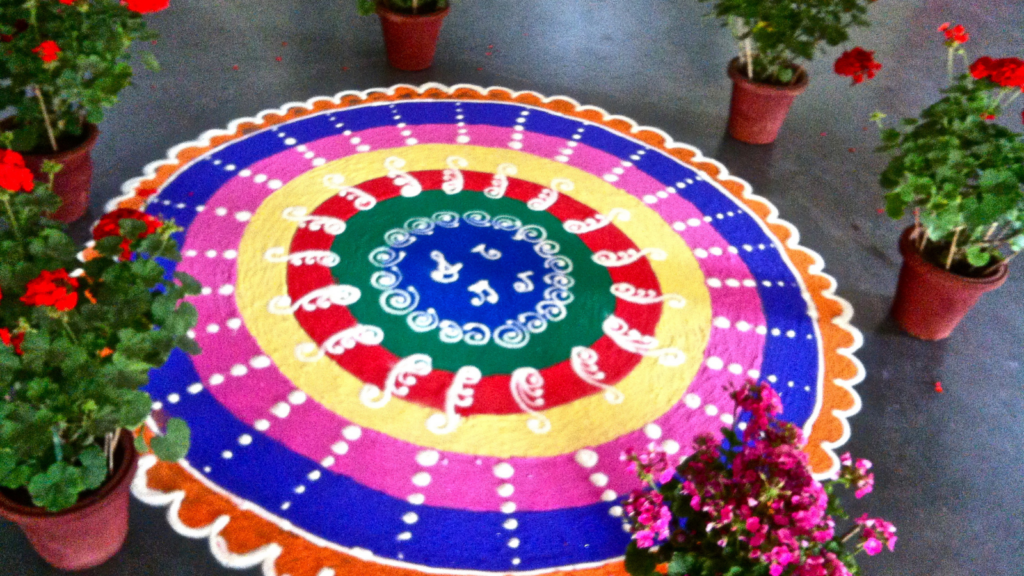Rangoli, an ancient art form steeped in tradition, is more than just an expression of creativity. It’s a symbol of good luck and prosperity, often crafted with meticulous precision and vibrant colors. But don’t be intimidated! With the right guidance, anyone can master the art of creating beautiful rangoli designs. This article dives into the world of easy rangoli design, perfect for beginners or those looking for a quick and simple way to brighten up their homes and gardens. Whether it’s for a festival, a special occasion, or just to add a touch of color to your everyday life, this easy rangoli design won’t disappoint. So, let’s embark on this colorful journey together.
Easy:hb–x0w2qoe= Rangoli Design
The Cultural Significance of Rangoli
Derived from a Sanskrit word, ‘Rangavalli’, rangoli’s roots trace back centuries as an expression of warm hospitality, beauty, and auspiciousness. This decorative art form, seen at the entrance of homes, is believed to attract goddess Lakshmi, the deity of wealth. Not merely an art, rangoli’s patterns often incorporate symbols of positivity and beauty, such as peacocks or lotus flowers, and are an integral part of festivals like Diwali, Onam, and Pongal. Therefore, rangoli stands as a cultural emblem, drawing together motifs of spirituality, hospitality, and the trends of beauty, and artistry.
Materials Used for Rangoli

Creating a rangoli typically involves commonplace materials easily found in any household. Traditionally, powdered rice or chalk was the main ingredient but over time, colored powders, sand, and even flower petals have become common substitutes. The use of these materials not only add to the vibrancy of the designs but are also seen to be more eco-friendly. Rangoli tools, like stencils, dotted plates, or simple hand-held funnels, are essential aids in crafting these ornate patterns. Thus, rangoli showcases how simple materials transform into a monumental testament of human creativity and cultural significance.
Easy Rangoli Design Ideas
Floral Patterns

Floral designs in rangoli present an admirable amalgamation of nature’s enchantment and human creativity. Numerous floral rangoli designs feature motifs of flowers like lotuses and marigolds, accentuated by leaves and tendrils. These designs, often circular, radiate serenity and symmetry. A beginner can start with a central blossom and radiate outwards, adding increasingly intricate petals. Not only do these designs convey admiration for nature’s wonders, but they also echo the auspiciousness associated with the art of rangoli.
Geometric Patterns
Geometric patterns in rangoli are a testament to the mathematical roots of this artistic discipline. Consisting of prominent lines, squares, circles and triangles, these designs reflect precision and order. An elemental geometric rangoli design might commence with a simple square or circle, gradually expanding to larger shapes or patterns. Significantly, the inclusion of dotted grids can make these designs easier to follow, which is especially beneficial for beginners. This easy rangoli design embody the perfect combination of artistry and geometry.
Tips for Creating Easy Rangoli Designs
Choosing the Right Materials

Success in rangoli resides partly in the choice of materials. Colored powders, traditionally made from rice flour or sand, offer an ideal and authentic medium for rangoli art. But, they can find replacements in ordinary kitchen items like turmeric, vermilion, or even coarse salt colored with food dyes. For those seeking permanence, acrylic paint emerges as another handy option, especially on hard, non-absorbent surfaces. Using pre-made rangoli stencils simplifies the process, enabling beginners to create stunning designs with precision and ease.
An Expression of Creativity
Having explored the rich tradition of rangoli and the simplicity of creating an easy rangoli design, it’s clear that this art form is much more than just a display of colors. It’s a symbol of hospitality, prosperity, and spiritual expression. With the right materials and a few simple techniques under your belt, you’re well on your way to mastering this ancient art. Whether you’re using traditional colored powders or experimenting with alternatives like turmeric or coarse salt, the key is to let your creativity flow. Pre-made stencils can be a great starting point for beginners, helping you achieve precision while you learn. So, why not embrace the vibrant world of rangoli? It’s not just about creating beautiful designs, it’s about embracing a tradition that’s steeped in culture and spirituality.

